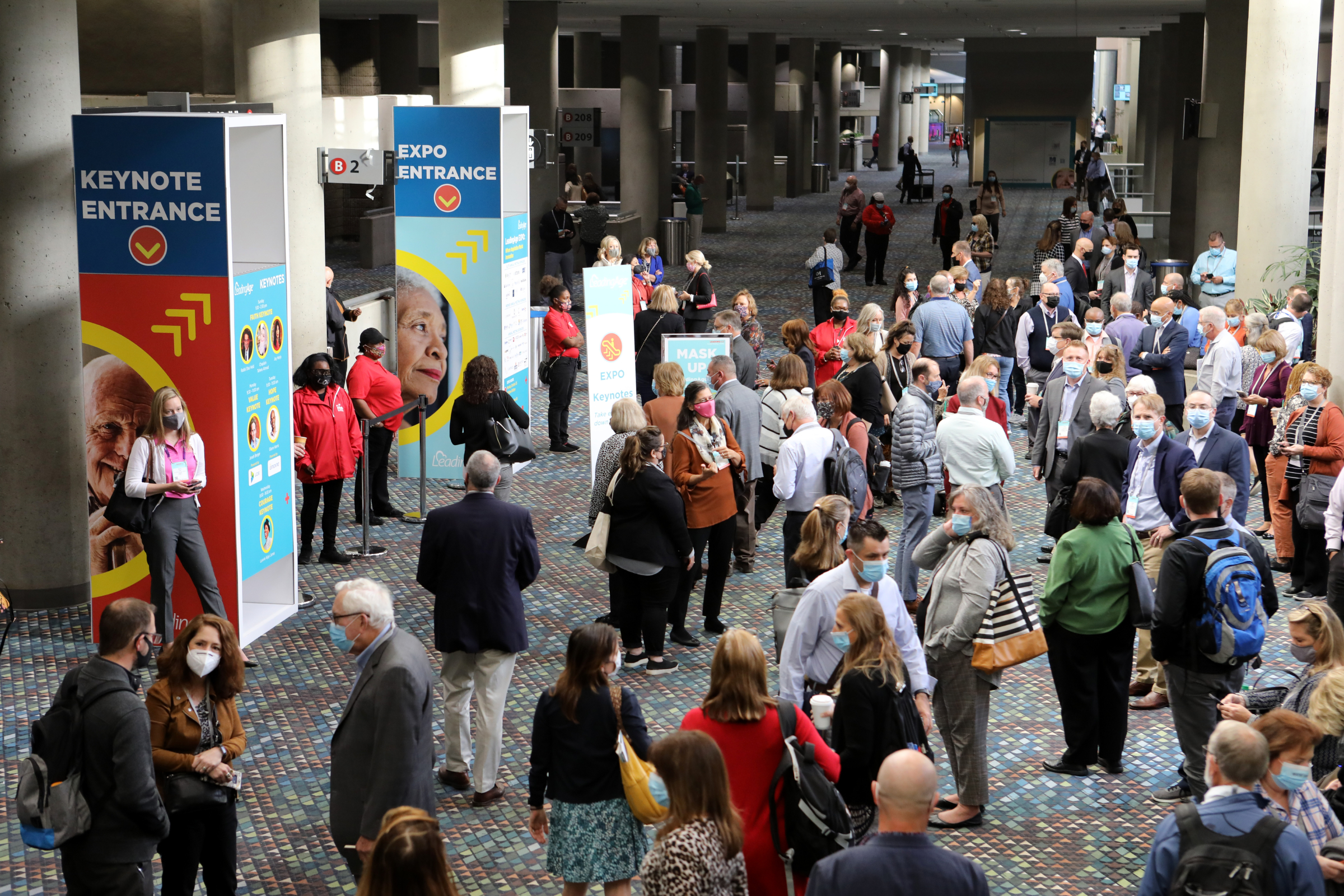Health Disparities Highlighted by COVID-19 Data
WHAT DOES COVID-19 DATA TELL US?
Even as the COVID-19 drama continues to unfold, researchers are combing the limited available data to look for patterns. We know that older individuals are more likely to suffer worse health outcomes (and death) from COVID than younger individuals. Who among the older population, particularly nursing home residents, is most affected by this novel coronavirus? Why are some nursing homes able to remain COVID-19 free while others experience significant outbreaks? While the answers are still far from conclusive, one thing is tragically clear – COVID-19 exploits longstanding health disparities and we are still a long way from racial and economic justice in this country.
WHAT HAVE WE LEARNED SO FAR?
- Nearly every study reviewed found that older African American individuals were far more likely to become infected with COVID-19 and were far more likely to be hospitalized.
- Medicare data indicates that people who are covered by both Medicaid and Medicare are four times more likely to be hospitalized than those who are Medicare-only beneficiaries.
- Many major studies correlated widespread COVID-19 infection in the surrounding community with greater likelihood of COVID-19 in the nursing homes.
- Most studies found no correlation between Five-Star Ratings and likelihood of COVID-19 infections/outbreaks in nursing homes, although two state-specific studies did find that four and five star homes were likely to have fewer cases of COVID-19.
- One study found that there were more diagnoses of COVID-19 in facilities that had a higher number of admissions in the prior year; another found that larger facilities had higher rates of COVID-19, while yet another found that size did not correlate to infections on a per bed basis.
- One study found higher rates of COVID in for profit nursing homes compared to not for profit and government-operated nursing homes.
- Two major researchers concluded: “COVID-19 has exposed long-standing issues in how nursing home services are structured and financed.” And they conclude that, “Nursing homes are in crisis because of the COVID-19 pandemic. These facilities need immediate support from policy makers and clinicians including testing, PPE, and support for staff. When nursing homes are able to reopen, this need for clinical support will not end.”
- Until the standardization and consistency of reporting is better established, it will be difficult to draw conclusions about the many variables which may influence the prevalence of COVID-19 cases and deaths in particular nursing homes or other congregate settings. Variability in rates of testing over the past several months, differences in the ways in which deaths and cases have been reported, the varying methodologies and dates of these limited studies, and the particular data sources make it difficult to draw conclusions today.
WHAT DOES THIS MEAN FOR LEADINGAGE MEMBERS?
- LeadingAge members must find ways to promote the elimination of racial and economic health disparities. It is time to educate and engage conversations within our organizations and join with others in our communities to make a difference.
- The seeming correlation between rates of COVID-19 in the wider community and those in nursing homes argues for ongoing education of staff and residents as states reopen and cases surge again in some areas.
- Despite some media attempts to villainize nursing homes for the presence of confirmed cases of COVID-19, these early studies indicate that these are complex intersections, not easily understood nor characterized.
- LeadingAge members need to stay abreast of emerging research in order to ensure they are taking every precaution for the safety of residents and staff members. Learning what has worked allows for replication and sharing promising practices.
- Many of the issues that have emerged during the COVID-19 pandemic reflect longstanding issues with the long term care system’s structure and funding. Join with LeadingAge to advocate for change!
SUMMARY OF REVIEWED STUDIES
CMS Medicare Snapshot
On June 22, 2020, CMS released a snapshot of Medicare FFS, Medicare Advantage and enrollment data from January 1 – May 16, 2020. https://www.cms.gov/files/document/medicare-covid-19-data-snapshot-fact-sheet.pdf?source=email.
Cautioning that the data is not designed for public health surveillance purposes and there are likely claims lags, the data showed that Medicare beneficiaries had a total of 326,674 diagnosed COVID-19 cases. The data showed stark health disparities.
While Medicare only beneficiaries had 325 cases per 100,000 people, dual Medicare/ Medicaid beneficiaries had 1,406 cases per 100,000. Males (508/100,000) and females (527/100,000) had similar rates of infection, but race told a very different story in rates per 100,000 people:
- Black = 1,107
- Hispanic = 692
- Asian = 455
- Other/unknown = 440
- White = 417
Hospitalizations for COVID-19 (total 109,607) showed similar patterns. Black people were hospitalized at nearly four times the rate of white people and Hispanic people at twice the rate of white people. Individuals with both Medicare and Medicaid were hospitalized more than four times as often as individuals with Medicare only. In light of this data, CMS and the Trump administration are calling for a great emphasis on value based care. A FAQ document on this data snapshot can be found here – https://www.cms.gov/files/document/medicare-covid-19-data-snapshot-faqs.pdf
Multi-State Studies
Abrams, Loomer, Gandhi and Grabowski’s research on Characteristics of US Nursing Homes with COVID-19 Cases, published June 2, 2020, in the Journal of the American Geriatrics Society https://onlinelibrary.wiley.com/doi/10.1111/jgs.16661looked at 9,345 nursing homes across 30 states for which health department data was available on May 11, 2020. In exploring what accounted for higher numbers of cases in particular nursing homes, they did not find a correlation with Five-Star Quality Ratings, prior infection control violations, percentage of Medicaid residents, or ownership. However, a great percentage of African American residents, larger facility size, urban locations, non-chain status, and rates of infection in the state related to an increased probability of having positive cases of COVID-19.
Vincent Mor of Brown University indicated that the high concentration of COVID-19 cases in nursing homes and assisted living communities in the United States is similar to the situations in Australia, Singapore, Norway, Israel, France. His research indicated that the size of the facility and the number of cases per 100,000 in the county in which the nursing home is located are the greatest predictors of COVID-19 cases. He reports that regression analyses show that infection rates are unrelated to quality rankings, as long as proper study controls for population levels are put in place. He said that positive cases are more likely to appear in facilities that have had more admissions per bed in the year prior.
In a joint article published May 22, 2020 in JAMA Network, Grabowski and Mor discuss Nursing Home Care in Crisis in the Wake of COVID-19.
They believe that “COVID-19 has exposed long-standing issues in how nursing home services are structured and financed.” And they conclude that, “Nursing homes are in crisis because of the COVID-19 pandemic. These facilities need immediate support from policy makers and clinicians including testing, PPE, and support for staff. When nursing homes are able to reopen, this need for clinical support will not end. Value-based payment models that meaningfully engage clinicians in both postacute care and long-term nursing home care should help nursing homes provide safe and appropriate care for patients recovering from COVID-19 and for other patients who require short-term or long-term nursing home care.”
R. Tamara Konetzka, Ph.D, a University of Chicago researcher and technical adviser to CMS on the Nursing Home Compare rating system, provided testimony about her research on May 22, 2020 to the Senate’s Special Committee on Aging. https://www.aging.senate.gov/imo/media/doc/SCA_Konetzka_05_21_20.pdf
The University of Chicago study used a sample of nursing home data from 12 geographically diverse states, Nursing Home Compare 2020 information, Long Term Care Focus, and states’ publicly available lists of long-term care facilities with reported COVID-19 cases or deaths as of May 13, 2020. Her findings indicated that there was not a meaningful relationship between a nursing home’s Five-Star Rating and the probability of it having at least on COVID-19 case or death. However, there was a “strong and consistent relationship” between race and the disease with people of color being disproportionately affected. They found no difference by profit status and only a weak relationship to percentage of residents with Medicaid. They focused on the existence of at least one case or death, rather than on the numbers of cases due to the variability of testing and reporting practices across states.
State Specific Studies
California
One study, soon to be published in the Journal of the American Medical Directors Association, and conducted by researchers from California State University in Los Angeles and Biogen, examined data on 1,223 California skilled nursing facilities. https://www.sciencedirect.com/science/article/pii/S1525861020305211
They used longitudinal data on COVID-19 cases and deaths from April 23 – June 2, 2020 provided by the California Department of Public Health, 2019 Nursing Home Compare quality rating information, and demographic and other data from Long Term Care Focus. Their analysis showed that nursing homes with higher star ratings generally had a lower number of confirmed cases and deaths. Nursing homes with a lower percentage of white residents had higher numbers of cases and deaths, again reinforcing the level of health disparities. Compared with not-for-profit and government facilities, for profit facilities had higher numbers of cases and deaths, as did larger facilities. The authors describe a number of limitations to the study, including that the number of cases was also tied to testing capability and they did not have testing data and that they were not able to look at variables such as patient comorbidities, location and staffing patterns.
Connecticut
A study published last week in the Journal of the American Geriatrics Society, by lead researcher Yue Li at the University of Rochester studied 215 nursing homes in Connecticut. https://onlinelibrary.wiley.com/doi/abs/10.1111/jgs.16689
The study date was April 16, 2020. This study found that facilities with more registered nurses on duty had 22% fewer confirmed cases of COVID-19 than those with fewer RNs. Four and five star nursing homes had 13% fewer cases though this applied only to infections and not subsequent deaths. Nursing homes with a higher concentration of Medicaid residents had 16% more confirmed cases and homes with more ethnic minorities had 15% more confirmed cases. Again, the issue of testing capability and testing data is at play in this study conducted in mid-April.
Also looking specifically at the state of Connecticut, a Connecticut Mirror article of June 4, 2020 also asked why some nursing homes in the state were harder hit with COVID-19. https://ctmirror.org/2020/06/04/why-are-some-nursing-homes-hit-harder-by-covid-19-data-offers-clues/
The article offered a variety of perspectives on the issue. On the one hand, their analysis using CMS data, saw a correlation between infection control problems and COVID-19 cases. And there was also a higher incidence of COVID-19 in nursing homes with a higher percentage of people of color, again reinforcing awareness of disparities.
However, the article also cited Dr. Patrick Coll, associate director for clinical geriatrics at UConn Health’s Center on Aging, who said there are many unknowns as to why certain facilities and people are impacted more harshly. He suspects that lapses in following infection-control guidelines played a small role, while lack of testing, and therefore quarantining, of staff and residents was the chief reason the virus spread so quickly. “My feeling is that the occurrence of COVID-19 in a nursing home doesn’t mean that the facility did not follow standards with regards to infection control. They have been very, very serious with regards to their infection control measures, and they still saw significant numbers,” said Coll, who consults for a handful of the facilities. “Most likely, it was asymptomatic staff. So staff who didn’t know they had COVID were coming into work and they may have been exposing some of the residents to the virus.”
The Connecticut Mirror went on to say, “Officials at DPH said they believe nursing homes here have been hit particularly hard because New York City and the region has been the nation’s epicenter for COVID-19 infections. Barbara Cass, the agency’s branch chief for health care and quality safety, said that “it could be a host of things.” It could be that some nursing homes have older residents, or have more severe health issues or are located in urban centers where there are heavier concentrations of the disease, she said.”
New Jersey
In early May 2020, the New Jersey Department of Health engaged Manatt Health to undertake a rapid assessment of the state’s COVID-19 response targeted toward the long term care system. https://www.manatt.com/Manatt/media/Documents/NJ-LTC-Report.pdf
Through a literature review, data analysis, stakeholder interviews, and a review of national best practices, Manatt focused primarily on nursing homes and special care nursing facilities. They note that this is a rapidly evolving pandemic and the report represents only a short window of time.
With initial positive COVID-19 cases during the first week of March and peaking through early April, New Jersey was one of the first states to have serious outbreaks. Based on available data, strong and consistent patterns between nursing home COVID-19 cases and deaths and potential predictive characteristics were not immediately evident. Early observations included:
- The Central East, Central West, and South regions had fewer COVID-19 cases per 1,000 people and fewer nursing home cases per licensed bed compared to the North East and North West; in other words, with some exceptions, the intensity of COVID-19 cases in nursing homes largely mirrored their surrounding communities.
- Larger nursing homes have not had a higher rate of confirmed COVID-19 cases or deaths on a per licensed bed basis than smaller nursing homes.
- For-profit and not-for-profit nursing homes have had similar rates of COVID-19 cases and deaths per licensed bed (additional in-depth analysis recommended); however, data were not available to consider for-profit and not-for-profit subgroups.
- An observed relationship has not been identified between the Centers for Medicare and Medicaid Services’ (CMS) Nursing Home Compare overall Star rating or quality star ratings and total COVID-19 nursing home deaths per licensed bed in New Jersey. (Continuing evaluation is happening across the industry, including new reporting requirements for direct reporting to CMS, and these issues are anticipated to receive much scrutiny in the coming months.)
- Weak relationships – if any – have been observed between number of COVID-19 deaths per licensed bed and nursing home health and infection control deficiencies given available data.
Observations
The COVID-19 story continues to evolve, but one theme runs through nearly every study: older people, people of color and people with lower incomes have been disproportionately affected by this disease. This is yet another confirmation of longstanding disparities which should be addressed aggressively.
Until the standardization and consistency of reporting is better established and recorded for a period of time, it will be difficult to draw conclusions about the many variables which may influence the prevalence of COVID-19 cases and deaths in particular nursing homes or other congregate settings. Variability in rates of testing over the past several months, differences in the ways in which deaths and cases have been reported, the varying methodologies and dates of these limited studies and the particular data sources make it difficult to draw conclusions today.

Most Recommended
February 29, 2024
Say Yes to Lobby Day!
April 05, 2024
Cyberattack Updates: Change Healthcare Payment Platform
March 27, 2024
 Colleagues on the Move, March 27, 2024
Colleagues on the Move, March 27, 2024
April 12, 2024
Improving Medicare Advantage
Recently Added
April 12, 2024



